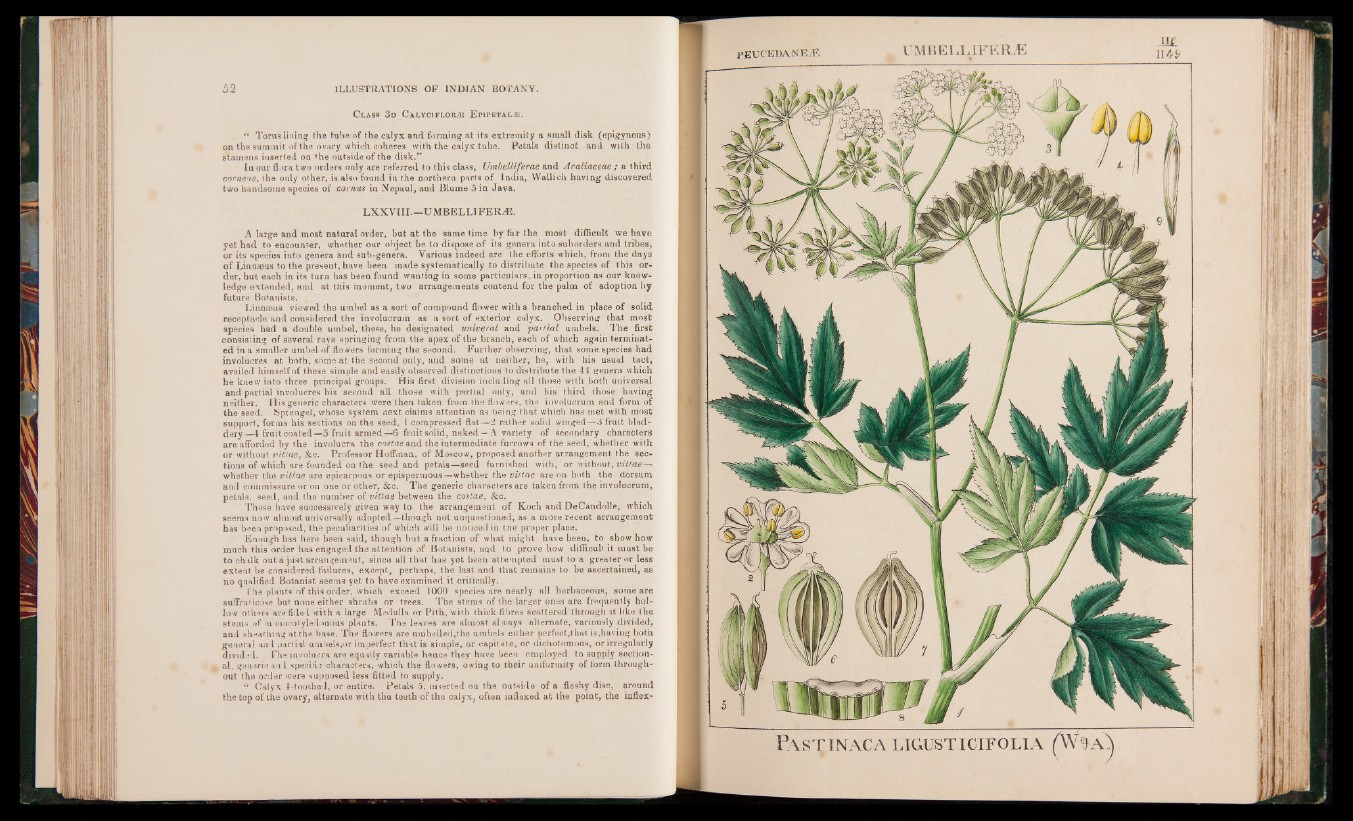
C lass 3 d C alyciflor® E pipetal® .
tc Torus lining the tube of the calyx and forming at its extremity a small disk (epigynous)
on the summit of the ovary which coheres with the calyx tube. Petals distinct and with the
stamens inserted on *he outside of the disk.”
In our flora two orders only are referred to this class, Umbelliferae and Araliaceae ; a third
cornene> the only other, is also found in the northern parts of India, Wallich having discovered
two handsome species of comas in Nepaul, and Blume 5 in Java.
LXXVIII.—UMBELLIFERA3.
A large and most natural order, but at the same time by far the most difficult we have
yet had to encounter, whether our object be to dispose of its genera into suborders and tribes,
or its species into genera and sub-genera. Various indeed are the efforts which, from the days
of Linnaeus to the present, have been made systematically to distribute the species of thi3 order,
but each in its turn has been found wanting in some particulars, in proportion as our knowledge
extended, and at this momeut, two arrangements contend for the palm of adoption by
future Botanists. ..
Linnaeus viewed the umbel as a sort of compound flower with a branched in place of solid
receptacle and considered the involucruin as a sort of exterior calyx. Observing that most
species had a double umbel, these, he designated univeral and partial umbels. 'The first
consisting of several rays springing from the apex of the branch, each of which again terminated
in a smaller umbel of flowers forming the second. Further observing, that some species had
involucres at both, some at the second only, and some at neither, he, with his usual tact,
availed himself of these simple and easily observed distinctions to distribute the 44 genera which
he knew into three principal groups. His first division including all those with both universal
and partial involucres his second all those with partial only, and his third those having
neither. His generic characters were then taken from the flowers, the involucrum and form of
the seed. Spiengel, whose system next claims attention as being that which has met with most
support, forms his sections on the seed, 1 compressed flat—2 rather solid winged—3 fruit blad-
(Jery _ 4 fruit coated—5 fruit armed—6 fruit solid, naked — A variety of secondary characters
are afforded by the involucra the costae and the intermediate furrows of the seed, whether with
or without vittae, &c. Professor Hoffman, of Moscow, proposed another arrangement the sections
of which are founded on the seed and petals—seed furnished with, or without, vittae—?.
whether the vittae are epicarpous or epispermous—whether the vittae are on both the dorsum
and commissure or on one or other, &c. The generic characters are taken from the involucrum,
petals, seed, and the number of vittae between the costae, &c.
These have successively given way to the arrangement of Koch and DeCandolle, which
seems now almost universally adopted—though not unquestioned, as a more recent arrangement
has been proposed, the peculiarities of which will be noticed in the proper place.
Enough has here been said, though but a fraction of what might have been, to show how
much this order has engaged the attention of Botanists, aqd to prove how difficult it must be
to chalk outa just arrangement, since all that has yet been attempted must to a greater or less
extent be considered failures, except, perhaps, the last and that remains to be ascertained, as
no qualified Botanist seems yet to have examined it critically.
The plants of this order, which exceed 1000 species are nearly all herbaceous, some are
suffruticose but none either shrubs or trees. The stems of the larger ones are frequently hollow
others are filled with a large Medulla or Pith, with thick fibres scattered through it like the
stems of in mocotyledonous plants. The leaves are almost always alternate, variously divided,
and sheathing at the base. The flowers are umbelled,the umbels either perfect,that is,having both
general and partial umbels,or imperfect that is simple, or capitate, or dichotomous, or irregularly
divided. The involucra are equally variable hence they have been employed to supply section-
* al, generic and specific characters, which the flowers, owing to their uniformity of form throughout
the order were supposed less fitted to supply.
“ Calyx 4-toothed, or entire. Petals 5, inserted on the outside of a fleshy disc, around
the top of the ovary, alternate with the teeth of the calyx, often indexed at the point, the inflexm
PEUCEDANEÆ ü M B E I i L I F E R Æ i 1149
P a STTNACA LIGUSTICIFOL1A